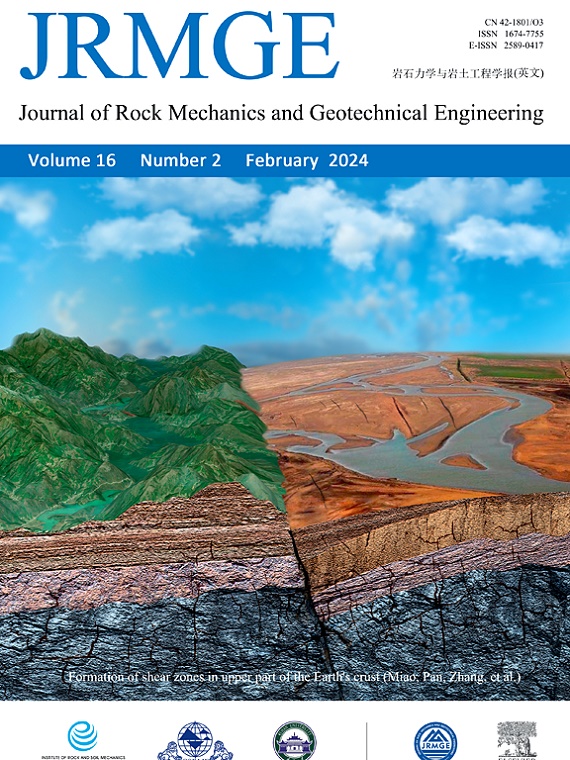解冻诱导软化对冻土断裂行为的影响
IF 10.2
1区 工程技术
Q1 ENGINEERING, GEOLOGICAL
Journal of Rock Mechanics and Geotechnical Engineering
Pub Date : 2023-10-01
DOI:10.1016/j.jrmge.2023.07.016
引用次数: 0
摘要
由于冻结岩石孔隙中存在冰和未冻水,岩石的断裂行为容易受到温度的影响。本研究通过测试不同温度(即- 20°C、- 15°C、- 12°C、- 10°C、- 8°C、- 6°C、- 4°C、- 2°C和0°C)下冻结岩石的拉伸断裂韧性(KIC),来评估解冻对冻结岩石断裂行为的潜在软化效应。采用声发射(AE)和数字图像相关(DIC)方法对压裂过程中的微裂纹扩展进行了分析。采用核磁共振(NMR)方法对孔隙冰的融化进行了测量。结果表明:(1)冻结岩石的KIC在−20℃~−4℃之间略有下降,在−4℃~ 0℃之间急剧下降。(2)在- 20℃~ - 4℃时,缺口尖端的DIC结果推导出的断裂过程分为弹性变形、微裂纹扩展和微裂纹合并三个阶段。然而,在- 4°C - 0°C时,只观察到后两个阶段。(3)在- 4°C ~ 0°C,压裂过程中的声发射活动比- 20°C ~ - 4°C时少,但小事件较多。(4)核磁共振结果表明,孔隙冰含量随温度的升高呈相反的变化趋势,即先适度减小后急剧减小,−4℃正是临界温度。接下来,我们将冻结岩石微观结构的演变与宏观断裂行为联系起来,解释了解冻引起的软化效应:从- 20°C到- 4°C,未冻水膜的增厚降低了冰与岩石骨架之间的胶结强度,导致断裂参数减小。从−4℃到0℃,冰的胶结作用几乎消失,孔隙冰的填充作用明显减弱,有利于微裂纹的扩展,使冻结岩石更容易破裂。本文章由计算机程序翻译,如有差异,请以英文原文为准。
Effects of thawing-induced softening on fracture behaviors of frozen rock
Due to the presence of ice and unfrozen water in pores of frozen rock, the rock fracture behaviors are susceptible to temperature In this study, the potential thawing-induced softening effects on the fracture behaviors of frozen rock is evaluated by testing the tension fracture toughness (KIC) of frozen rock at different temperatures (i.e. −20 °C, −15 °C, −12 °C, −10 °C, −8 °C, −6 °C, −4 °C, −2 °C, and 0 °C). Acoustic emission (AE) and digital image correlation (DIC) methods are utilized to analyze the microcrack propagation during fracturing. The melting of pore ice is measured using nuclear magnetic resonance (NMR) method. The results indicate that: (1) The KIC of frozen rock decreases moderately between −20 °C and −4 °C, and rapidly between −4 °C and 0 °C. (2) At −20 °C to −4 °C, the fracturing process, deduced from the DIC results at the notch tip, exhibits three stages: elastic deformation, microcrack propagation and microcrack coalescence. However, at −4 °C–0 °C, only the latter two stages are observed. (3) At −4 °C–0 °C, the AE activities during fracturing are less than that at −20 °C to −4 °C, while more small events are reported. (4) The NMR results demonstrate a reverse variation trend in pore ice content with increasing temperature, that is, a moderate decrease is followed by a sharp decrease and −4 °C is exactly the critical temperature. Next, we interpret the thawing-induced softening effect by linking the evolution in microscopic structure of frozen rock with its macroscopic fracture behaviors as follow: from −20 °C to −4 °C, the thickening of the unfrozen water film diminishes the cementation strength between ice and rock skeleton, leading to the decrease in fracture parameters. From −4 °C to 0 °C, the cementation effect of ice almost vanishes, and the filling effect of pore ice is reduced significantly, which facilitates microcrack propagation and thus the easier fracture of frozen rocks.
求助全文
通过发布文献求助,成功后即可免费获取论文全文。
去求助
来源期刊

Journal of Rock Mechanics and Geotechnical Engineering
Earth and Planetary Sciences-Geotechnical Engineering and Engineering Geology
CiteScore
11.60
自引率
6.80%
发文量
227
审稿时长
48 days
期刊介绍:
The Journal of Rock Mechanics and Geotechnical Engineering (JRMGE), overseen by the Institute of Rock and Soil Mechanics, Chinese Academy of Sciences, is dedicated to the latest advancements in rock mechanics and geotechnical engineering. It serves as a platform for global scholars to stay updated on developments in various related fields including soil mechanics, foundation engineering, civil engineering, mining engineering, hydraulic engineering, petroleum engineering, and engineering geology. With a focus on fostering international academic exchange, JRMGE acts as a conduit between theoretical advancements and practical applications. Topics covered include new theories, technologies, methods, experiences, in-situ and laboratory tests, developments, case studies, and timely reviews within the realm of rock mechanics and geotechnical engineering.
 求助内容:
求助内容: 应助结果提醒方式:
应助结果提醒方式:


